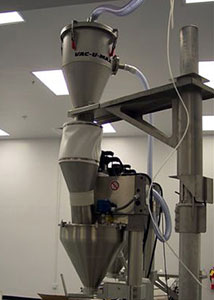Dry Processing
Fine flour flow for noodles
Switching to a pneumatic conveying system helped a noodle maker instill safety, efficiency and energy savings into its material handling process.
A family-owned and operated business based in an Amish community in Fredericksburg, OH, Mrs. Miller’s Homemade Noodles produces 40,000 lb. of noodles per week. The company is dedicated to using the best ingredients to produce high-quality, preservative-free, homemade products.
But the processors needed a new material handling system to keep its manual labor requirements to a minimum. “The goal was to implement a system that would efficiently convey 20 tons of very fine flour per week and eliminate the need for manual filling,” says Brian Miller, plant engineer for Mrs. Miller’s Homemade Noodles. An older, pressure-based material handling and conveying system transported the flour from a hopper through a volumetric feeder to a mixer.

|
| Mrs. Miller’s Homemade Noodles switched from a pressure system to a Vac-U-Max pneumatic material conveying system to move 20 tons of sticky, but fine, flour through the plant with less labor. Source: Vac-U-Max. |
The noodle maker received the flour in 50-lb. bags. “Our guys were climbing up to a big hopper and would fill it by hand sometimes, which is dangerous,” says Miller. Part of the transition to an updated material handling system included a change to 2,000-lb. bulk bags. Bags of this size remove the use of manual labor from the equation, shifting the handling burden onto the system. “The flour we use is like baker’s flour, and it is difficult to convey. It sticks to a lot of surfaces, and if you have leaks of any type in your system, you get a lot of dust,” explains Miller.
After some research, Miller found he could achieve his goals with a pneumatic conveying system. The noodle maker selected Vac-U-Max to custom build its pneumatic conveying system. “The new system is safer because it accommodates the odd-shaped super sacks and feeds the product directly from the bags without the use of manual labor,” says Miller.
Fine powders can pose a variety of conveying issues, which include sticking and becoming airborne. One way Vac-U-Max handles the problems with fine powders is by applying a high-polish finish to its conveyors’ interior and exterior surfaces. “The inherent nature of the pneumatic system prevents loose powder from becoming airborne, making for a cleaner and safer environment. The system is completely enclosed, and there is no mess,” states Miller.
The Vac-U-Max system also reduces space requirements and provides energy savings. The smaller footprint and high productivity of the system in place at Mrs. Miller’s allowed the company to eliminate a big hopper used with the previous system, which Miller cites as a great benefit.
The system operates with fewer moving parts than a pressure-based conveying system because it works on compressed air instead of electricity. The Vac-U-Max system allowed the company to eliminate electric motors that were running in the process, reducing energy costs and lowering plant noise. The pneumatic system uses compressed air to move about one cubic foot per conveying cycle. “I was concerned about the compressed air and the flow rate required by the system, but it has worked very well and has not been a problem,” says Miller.
For more information:
Vac-U-Max, 888-241-6992, info@vac-u-max.com
Looking for a reprint of this article?
From high-res PDFs to custom plaques, order your copy today!



-Nissin_Foods_70662_03003_Cup_Noodles_Chicken_Unit_JPEG.webp?height=200&t=1700704829&width=200)



